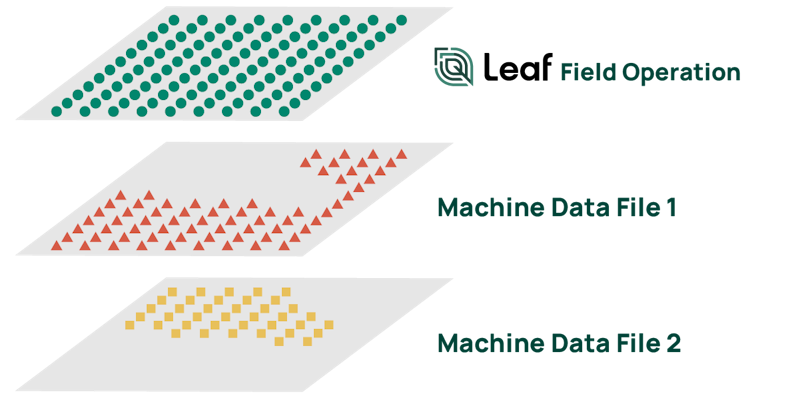Leaf’s Field Operations service allows developers to work with complete and continuously updating field operation datasets instead of fragmented machine data files. This significantly reduces the complexity of working with Machine Data and helps developers work directly with the data they need without needing to worry about file conversion, geospatial mapping, merging, and data deduplication.
Why Field Operations Matter
Machine data files are difficult to work with for several reasons:
-
They are stored in proprietary formats with different data structures, resolutions, naming conventions, crop codes etc. Leaf’s core Machine Data service solves this by detecting file types and converting machine data files into a consistent, standard format.
-
Each machine data file represents an arbitrary subsection of a field's data.
- This means that to use basic information in an application (e.g “how many seeds did I plant on this field” or “when did I finish harvest last year”), developers must first build infrastructure to ingest all of these files, map them together, determine which belong to the same operation, merge the matching files, remove duplicate data, and then continuously update the resulting operations. This is difficult to build and very difficult to maintain at scale!
Leaf’s Field Operations service creates and updates full Field Operations from the base Machine Data files. Field Operations represent full planting, application, harvest, or tillage operations so developers can access complete data without needing to worry about managing files. This allows developers to focus more of their effort on their core products and less time building and maintaining Machine Data file management infrastructure.
How It Works
Every time a new file is sent to Leaf via API connection or local file upload, Leaf’s Field Operations service automatically checks the file to see if it matches an existing Field Operation and should update that operation or if a new Field Operation should be created.
-
If an existing Field Operation should be updated, the new file is merged into the existing full operation dataset.
-
If a new Field Operation should be created, a new Field Operation entity will be created and the file will act as the base file to be merged with any future files that match that Field Operation.
Field Operation data can be retrieved as a standardGeoJSON of all points, a summary JSON of the Field Operation, and as a rendered map of the Field Operation. These outputs are standardized and consistent across all providers and data processed by Leaf so you can become compatible with all Machine Data sources via a single integration.

Additionally, there are a number of Field Operation Alert events to notify you when an operation has been created or updated for example.
Benefits of Using Field Operations:
-
Speed and simplicity
- Field Operations allow developers to get the data they need immediately and without needing to build or maintain excess infrastructure.
-
Focus on delivering value to customers
- Leaf does the background work so developers no longer need to handle issues like reading individual files, determining which belong together, merging files (without duplicating data), validating the output, and scaling this process for millions of files.
-
Unlock new use cases
- With Leaf's Field Operations, data from multiple machines and even multiple brands can be merged together to form full operations.
-
No compromise
- Developers working on advanced use cases can customize the Field Operations service and access the underlying services for full control. Processed data is available as standardized point data, a summary of the full Field Operation, and images of the Field Operation.
Will It Work For Me?
Leaf's Field Operations service is highly configurable to accommodate a wide variety of use cases. For example, you can use Configurations to set your own rules for when and how files should be included in an existing Field Operation. This includes parameters like percent overlap thresholds between fields and files, distance between points, time between file creation, and many more.
In addition, the Field Operations service is build upon of a series of independently exposed Leaf services including file merging and getting files by polygon or Field ID. This means that you can choose to manage pieces of the service yourself while Leaf does the rest.
Get Started!
Visit Leaf's Documentation to learn more about how to use Leaf’s Field Operations service.
